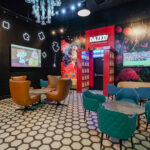Although I knew Thailand’s cannabis history is long, I believed legalization in the country to be implausible. I was wrong. Shortly after South Korea’s medical legalization announcement on November 23, 2018, Thailand released similar news. South Korea’s system came with far greater regulation. Even today, only a few cannabis-based products exist in the country’s market.
Believed to have been introduced to Thailand by way of India (because people in both regions refer to the plant as “ganja”), cannabis was condemned by politicians and police for decades even though it traditionally had been used as a food supplement, source of fiber, and holistic medicine for the elderly. Hemp products and textiles, too, were a common sight long before prohibition of the plant in the 1930s. Industry advocate Kitty Chopaka tells stories about older Thai generations growing ganja in the garden next to green chiretta and sea holly. Most commonly, the dried herb was used in teas and tinctures. Laborers used the versatile plant as a muscle relaxant, and women used it to alleviate labor pain.
Popular Thai strains
Baby Boomers and Gen Xers likely are familiar with the term “Thai stick.” This form of consumption, made popular in the domestic weed movement of the 1970s, is a unique and original take on what Millennials would consider a “cannagar.” The cigar typically consists of fully cured flower skewered on a bamboo stick, then rolled in the plant’s fan leaves before being wrapped with hemp string. While we’ve seen a small rebirth of the format in recent years, the modern-day cannagar carries far more clout with contemporary consumers in the United States.
Those who track landrace cultivars are familiar with the Thai strain. The pure sativa cultivar earned “street cred” due mostly to the rap and hip-hop music scenes. Prodigy referenced “Thai weed” in Mobb Deep’s song “Give It Up Fast.” The legendary, late Tupac Shakur also referenced the cultivar in his song “Outlaw.” He shared how he’d hit “high speeds and Thai weed on the freeway.” Even icons Dr. Dre and Eminem referenced Thai weed in their lyrics. It’s just one of those cultivars that has stood the test of time, often being cross-bred with domestic American cultivars to introduce its resilience and terpene profile. The strain has genetic lineage associated with the Blueberry strain and several modern-day Haze iterations around the world.
Cultivation, importing, exporting
Until the Marijuana Act B.E. 2477 of 1934, no laws related to cannabis existed in Thailand. Like other Asian countries at the time, including Japan and China, cannabis was one of several cash crops upon which the domestic economy depended. Even before 1934, though, Thailand experienced restrictions affecting cannabis due to the nation becoming a signatory to the Opium Convention of 1912. This agreement was amended in 1928 to restrict legal-hemp-growing counties from exporting the crop to areas where hemp was prohibited, under the rationale cannabis and hemp supported the opium trade. Where the connection was drawn between a suppression of opium consumption and cannabis escapes me to this day.
Today, Thai elders still share stories about growing up on cannabis farms with minimal interference from police or government officials. One would assume that even during the early nineteenth century people believed cannabis consumption to be a victimless crime. In fact, Thai farmers helped introduce Thai sticks to Americans. The connection may surprise you, but think back to what was going on in Asia for a good part of the 1960s and ’70s: the Vietnam war. It’s well known that U.S. soldiers on leave escaped the jungles of Vietnam to quieter settings. The Thai border is only about 400 miles from Ho Chi Minh City, Vietnam. With Laos as a buffer between the two countries, soldiers found Thailand’s beaches to be a nice retreat from reality.
Long before today’s postal system was exploited for illegal transportation of cannabis, soldiers sent “sticks” to friends and family in the United States via the military postal system.
The term “bong” also has ties to the Land of Smiles, as Thailand is known. American soldiers consumed ganja from bamboo water pipes the locals called “bhaungs.”
Examining the increase in U.S. cannabis consumption in the 1970s paints an interesting picture of how much Thailand influenced the domestic culture as we know it today. Due to the demand created by U.S. soldiers, Thai Stick was acknowledged as a strain, and a desirable one. Consequently, Thailand became one of the world’s largest illegal exporters of cannabis for most of the ’70s and early ’80s. The United States Drug Enforcement Administration eventually collaborated with Thailand’s police force to bring an end to the illicit American trade. The illegal growers then shifted their focus to supplying Central and South America.
Modern Legal Landscape
In 2003, Thailand’s prime minister launched an all-out drug war (think Nixon-era antics) that killed virtually all exportation trafficking. Human rights groups have traced nearly 3,000 extrajudicial killings to the prime minister’s efforts. More than half of the alleged smugglers later were found to have had no connection to cannabis or drug trafficking.
Thailand, like the U.S., has had a tumultuous history with cannabis, but the future looks bright. Chopaka has hosted several cannabis conventions since legalization was announced. She compares the diversity and entrepreneurial mindset to that found in North America. Thailand became the first country to develop its own cannabis strain specifically for the legal medical marijuana program. The cultivar is a cross between a local strain and a foreign strain dubbed Issara 01 by researchers at Maejo University. As of March 2021, Thai households are allowed to grow up to six plants. The plants may be commoditized by the families and sold to local public hospitals to support the medical cannabis program.Thailand is yet another example of healthy evolution toward legalization. Like Portugal, the country is choosing a path less traveled to blaze the way forward in embracing what should have always been.

Lance C. Lambert spent years cultivating brands and telling stories, primarily in the mainstream digital media and marketing space prior to making the jump to the legal cannabis industry in late 2013. In 2021, he planted his knowledge and passion-first attitude at GreenBroz, where he’s tasked with growing the company’s footprint at home and in emerging markets around the globe.












[…] https://mgmagazine.com/business/growing-horticulture/thailands-cannabis-history-and-modern-evolution… […]